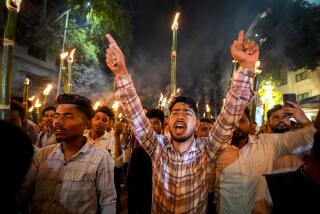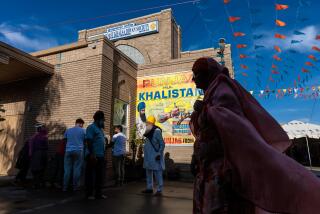From the Archives: Indian Americans: The ‘model minority’ has only started exerting its influence
THE 2.2 MILLION Indian Americans in the U.S. constitute a model minority, highly educated and well paid. And now, following in the footsteps of earlier immigrant groups such as the Irish, the Jews and the Cubans, Indian Americans are emerging as an influential force in Washington.
And look what just whizzed through the Capitol: the Henry J. Hyde U.S.-India Peaceful Atomic Energy Cooperation Act. The legislation, which allows U.S. government and private firms to sell nuclear technology to India for peaceful, civilian purposes, was thought to be dead on arrival as recently as March. But it won surprising support, even from nonproliferation die-hard Democrats such as Nancy Pelosi.
At work behind the bill’s passage was the usual crew of lobbyists and U.S. companies, including General Electric, Boeing and Lockheed, which will reap the bulk of the $100 billion the deal is expected to generate.
But the bill’s biggest backer was the Indian American community, which united as a political power for the first time since immigrating to the U.S. in force 35 years ago. This group loves its adopted land; it also cares deeply about the country of its heritage. Led by businessman Swadesh Chatterjee of the U.S.-India Friendship Council, Indian Americans lobbied individually and collectively. They were so effective — and on an issue as controversial as nuclear technology, no less — that Undersecretary of State R. Nicholas Burns called the law the Indian Americans’ “coming-out party in the U.S.”
The nuclear deal cements a strategic U.S. shift toward India, said Chatterjee, and will “change old mind-sets both in India and the U.S.” It also confirms that the Indian diaspora is now an economic and political asset in both countries.
Indian American political action has been percolating for years. As professionals — mostly doctors and engineers — they spent their first decades working hard and ensuring Ivy League educations for their children. (More than 60% of Indian Americans have college degrees.) Now they are established, law-abiding and wealthy — median family income is nearly $70,000 — a prime source of human and financial capital for Washington.
They are present everywhere in the U.S., both geographically and professionally. Indian doctors were given U.S. visas in the 1960s and ‘70s, provided they practiced in underserved states such as Tennessee, Missouri and Nevada, and they have been quietly building relationships with leaders in those states. Motel owners in Texas, Illinois and New York have long cultivated ties to Democrats such as Bill and Hillary Rodham Clinton. Tech gurus such as Vinod Khosla, a co-founder of Sun Microsystems, are politically active in California. So are the U.S.-based alumni of the prestigious Indian Institutes of Technology, many of whom are Silicon Valley millionaires.
Professionals such as Rajat Gupta of McKinsey & Co. have penetrated the upper echelons of global management consulting and finance. The number of Indians on Wall Street doing everything from investment banking to trading is staggering. An estimated one-third of the professionals in the money-making derivatives industry — yes, those geeky PhDs working on complex algorithms and econometric models — are of Indian origin. The bridges to Bangalore from Silicon Valley were built by Indian American engineers and entrepreneurs.
All these native-born Indians — 90% of the Indians in the U.S. are first-generation emigres and the cream of India’s crop — came together to help the passage of the nuclear deal.
They took lessons from other successful ethnic group lobbies, especially the Jewish Institute for National Security Affairs. Throughout 2006, they took out ads in Roll Call and the Washington Post, held receptions on Capitol Hill, sent out hundreds of faxes and e-mail petitions, talked to congressional staffers and harangued their senators and representatives. Finally, they piled into buses and sped to Washington to lobby door to door on Capitol Hill.
When President Bush signed the bill on Dec. 18, 75 noted Indian Americans were invited to witness the event. Bush took singular care to thank the Indian American community’s effort, which he said “was vital to explaining this bill to our citizens and also to India.”
What’s next for Indian Americans? Exerting influence in the 2008 presidential elections, surely. In 2004, Indian Americans raised $5 million for the Democratic Party ($2 million for John Kerry alone) and $1.5 million for the Republican Party.
Though historically Indians are overwhelmingly Democrats, they are starting to lean Republican too, especially after this bill. Watch their moves — they’ve only just started.
MANJEET KRIPALANI, the Edward R. Murrow Press fellow at the Council on Foreign Relations, is writing a book on the effect of India on globalization and globalization on India.
More to Read
A cure for the common opinion
Get thought-provoking perspectives with our weekly newsletter.
You may occasionally receive promotional content from the Los Angeles Times.






